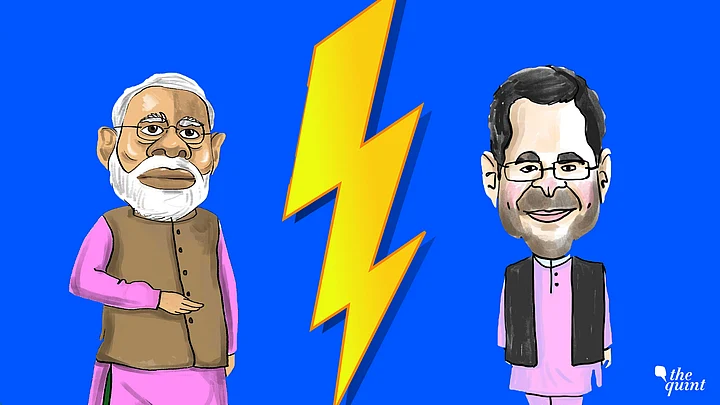I missed the live telecast of the recent CVoter survey on ABP. Since credible surveys indicate a broad trend and I assumed it to be one, I was curious to check out the findings of the latest ‘Mood of the Nation’ report.
After going through the highlights posted on the ABP website, I am still clueless as to how the magic figure of 276 for the National Democratic Alliance (NDA) was arrived at.
Is it a sum total of the best-case scenarios in all states for the ruling coalition? Why are the findings of Gujarat, West Bengal and Jharkhand missing from the website?
Unanswered Questions in the Survey
What are the constituents of the United Progressive Alliance other than the Congress? Have JD (S), TDP, NCP, RJD, Left parties, TMC or DMK been considered as the allies of the Congress and hence part of the UPA? The survey had a sample size of 32,000 voters spread across all the 543 Lok Sabha seats.
This means an average of nearly 60 respondents each in all the constituencies.
All that we are made to believe is that the NDA is expected to get 276 of the 543 Lok Sabha seats in the 2019 general elections. The survey also indicates marginal erosion in the NDA’s vote share and a perceptible dip in the prime minister’s popularity, from 69 percent in 2017 to 60 percent now. The survey findings however, have left many questions unanswered. Here are some:
- From the data posted on ABP, I could count 253 seats for the NDA. That is when I counted 70 in Uttar Pradesh, 31 in Bihar and 36 in Maharashtra for the NDA. There was NO information on 82 Lok Sabha seats of Gujarat, West Bengal and Jharkhand. Should we assume that the BJP/NDA is expected to get 23 of the 82 seats in these states? Was the final number counted with the assumption that the NDA remains rock solid while the Opposition continues to remain a fragmented lot?
Why Assume a Trend Reversal in 2019?
- Do people vote differently in assembly and Lok Sabha elections? All recent surveys, including the one done by CVoter in August, indicate a significant erosion in BJP’s support in the poll-bound states of Madhya Pradesh, Rajasthan and Chhattisgarh. But the current ABP-CVoter survey suggests that irrespective of what happens in the assembly elections, the BJP is going to do exceedingly well in Lok Sabha elections in Madhya Pradesh, Rajasthan and Chhattisgarh. Past data suggests that this has not been the case in the three states. The outcome of the last three Lok Sabha elections in these states has mirrored the voting behaviour witnessed in the assembly elections.
Why should we assume that we will have a trend reversal in 2019? Did the survey find something dramatic to suggest trend reversal? We have no clue from the published data.
- How will the BJP perform in southern states? According to the survey, the NDA is expected to win 21 out of the 129 seats in Karnataka, Tamil Nadu, Kerala, Andhra Pradesh and Telangana. The BJP had an identical tally in 2014. It had won 17 seats in Karnataka, 1 in Tamil Nadu and 3 in the then undivided Andhra Pradesh, an ally of the TDP. Now that the alliance with the TDP is broken, will the party repeat its last performance there? Will the party repeat its performance in Karnataka against the combined opposition of the Congress and JD (S)? What about Kerala and Tamil Nadu? The survey is silent on these issues.
- A significant gain in Odisha and no loss anywhere else, despite an erosion in NDA’s vote share? The survey expects the BJP to do exceedingly well in Odisha. For that to happen, the BJP has to make a dramatic improvement in its vote share from the current level of 22 percent. Assuming that is the case, the saffron party is expected to lose ground in other states, if the all-India vote share is expected to witness a dip of 2 percentage points as per the survey. In that case, can the BJP/NDA keep its tally intact in Bihar (31 out of 40), Delhi (7 out of 7), Haryana (6 out of 10, down 1 since 2014) and Uttar Pradesh (70 out of 80, down 3 since 2014)?
2019 Might be an Action Replay of 2014
- Will the results of the by-elections in the key states of Bihar, Uttar Pradesh and Maharashtra have no bearing on the outcome in 2019? Araria in Bihar, Gorakhpur-Phulpur-Kairana in Uttar Pradesh and Bhandara-Gondia in Maharashtra threw up surprising results in the recent by-elections. Were they freak outcomes and will they have no impact on the 2019 Lok Sabha elections? Araria has been a JD(U) bastion which was wrested by Lalu Prasad’s Rashtriya Janata Dal, an ally of the Congress. Gorakhpur has been Yogi Adityanath’s pocket borough, and BJP’s loss there signalled a dramatic shift. The survey outcome suggests nothing has changed.
From what we know, it seems 2019 is going to be an action replay of 2014, despite erosion in the popularity of the incumbent. Someone needs to tell us how is that possible.
